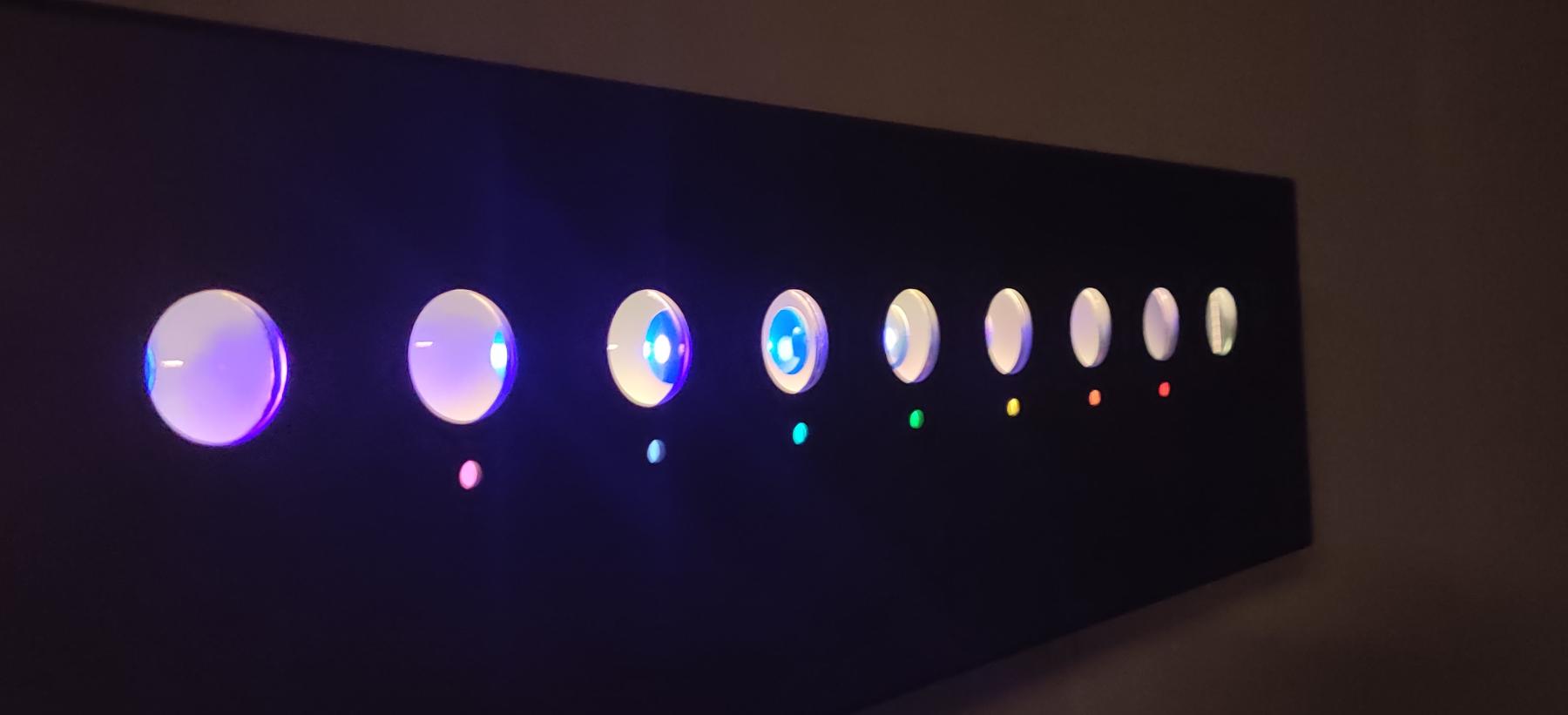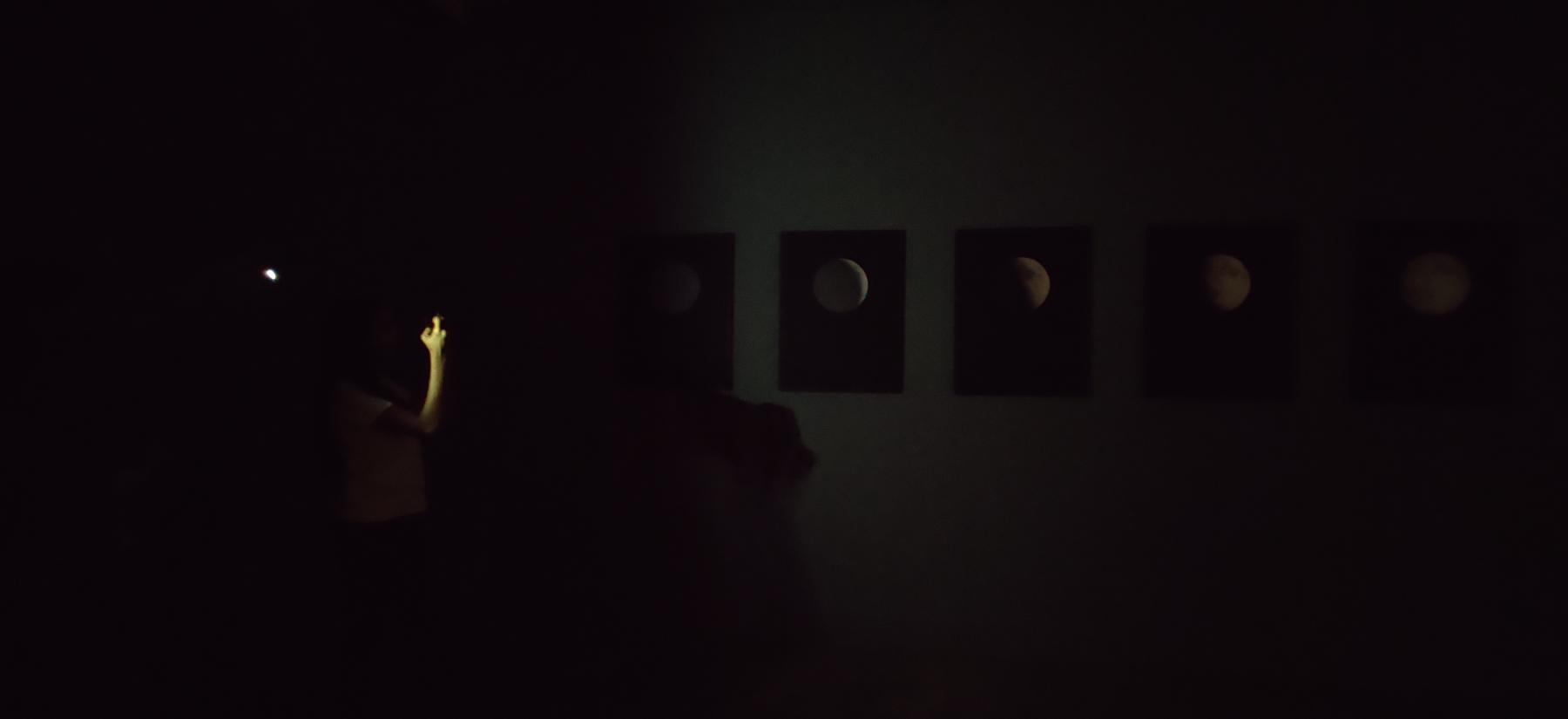Revisiting Phototrope: Afterimages and Between Presences
Phototrope, exhibited July 2022 at the Karnataka Chitrakala Parishath (popularly known as CKP), Bangalore, was the second solo show for artist Tahireh Lal. Consisting of an interpretive map of the night sky and a time-based installation in the main hall, spatially punctuated by text-based works referencing rhymes and verses, the show—enveloped in darkness—encouraged viewers to use torches to explore the works.
Upon entering the exhibition from the brightly-lit corridors of CKP, the contrasting light conditions between the spaces compelled the viewer’s eyes and body to adjust to the present lack of light. Just as a stray ray from a torch produced a flicker, forms began to appear, which helped steer the viewer within the space. Revealing themselves in fragments, the works operated through a gradual and subjective build-up of the image.
In his essay, “Commemorating the Present: Introductory Thoughts”, Peter D. Osborne focuses on how photography creates a realisation of the present and writes: “Conceptions of presence are commonly linked to proximity.” Extending Osborne’s statement, the first segment of the two-part essay evaluates how presences are generated and mediated via the conditions of visibility produced in Phototrope.

In The Twinkle Of Your Eye, 2022. Tahireh Lal. Retroreflective stickers on paper, 44 panels, 30 x 22 inches each.
In The Twinkle Of Your Eye employs retroreflective stickers to recreate a map of stars visible to the naked eye, akin to the night sky. What makes the retroreflectors intriguing is while the material is commercially used for making road signage to aid in reducing accidents at night, they are only visible to the source throwing light on them, appearing latent to anyone else sans a light source. Unlike industrial and mass-produced materials—that often induce a uniform response—the retroreflectors have the ability to create a string of fleeting appearances, whose activation and what it makes visible lies in the hands of the viewer, as made apparent in the show.
As the viewer flashes the torchlight upon the retroreflective stickers, the reflection renders the stars up-close, inviting the viewer’s gaze to move back and forth, reconstructing the sky in their mind’s eye. Even if the image—produced by stickers with colours corresponding to the temperature of the stars—appears flat, it’s how the material responds when interacted with that lends depth to the image. The low-light conditions of visibility offer a reflective moment to reorient one’s sensorium in a world where things are increasingly hypervisible, rarely allowing one to actually see.
The retroreflector unsettles the way one is largely conditioned to interact with surroundings and makes one sensitive to perceptual mechanisms. Retroreflectors allow the urban viewer to attend to their actual experience of the night sky, where the longer the sky is gazed at and observed, more stars enter the field of vision, starting with the brightest ones. This urban experience differs from the view of the night sky facilitated and generated nowadays by star gazing apps, where star maps are digitally rendered and stitched together to create a definite view of both hemispheres’ night sky. When the atmosphere of partial darkness is activated within the exhibition, the viewer is prompted to consider the structures that mediate image generation as one of the major factors affecting the visibility of stars in urban areas is light pollution, which is often aggravated by the use of glaring spotlights and floodlights.
Therefore, the work unearths the limits of our perception, apparatuses, and platforms through which we receive visual information, disrupting our sense of the world as cohesive to reveal it as a make-believe whole, and highlighting the actual experience of our surroundings as being highly fragmentary.

Colour Study in Ultraviolet, 2022. Tahireh Lal. Lenses, Colour Gels, UV LED, Electronics, Metal Case, 12 x 7.8 x 40 inches.
If the intensity of light plays a crucial role in how a form’s presence is evoked, and when it is made present and accessible, another important component that filters that light and mediates how an image forms on the screen of the retina or a camera is the lens.
Tahireh’s work Colour Study in Ultraviolet visibilises the materiality of light and operation of the lens—here, photochromatic lens—through a time-based installation that unfolds in two cycles over the duration of an hour. Encased within a metal box, ultraviolet light of different intensities is passed through a series of convex lenses coated with a colour gel filter visible below the lens. Each cycle of exposure was programmed to run for thirty minutes, at the end of which a shutter dropped. The very brief moment following the shutter drop and prior to the start of a new cycle made possible for the usually imperceptible wavelengths of UV light to be visualised by the differently darkened lenses before they returned to a clear state and the process restarted. The installation foregrounds the apparatus behind image generation, its mechanisms, parts, and properties—be the lens or its coating—and helps observe how they change over time, in turn affecting the reception of an image and its features. Rather than positing them as binaries, these considerations create a complex conversation between light and darkness.
Elucidating on the function of the lens in the essay “Screening nature (and the nature of the screen)”, W.J.T. Mitchell states, “The lens is an optical screen that, far from perfectly transparent, organises the light it transmits around considerations of focal length, resolution, and focus… occasionally it obtrudes itself in what are called ‘artifacts of the lens’.” While the darkened areas in the above work can be considered artefacts that change over time, another work in the show presents the technological, institutional, and cultural lenses that govern the inception and reception of the source image, through the organisation of visual information by varying agents ranging from image applications to the photographer.
Moonlight emphasises the manner in which an image of the moon is made proximal and its spatial imagination is rendered, by placing the reference point at a higher eye level than the rest to mimic the upward gaze. The work references open-source images of the key phases of the moon released by NASA by digitally printing their likeness on retroreflectors. Historically, the Apollo 11, 14, and 15, and the Lunokhod 1 and 2 missions have placed five retroreflectors on the moon to help measure its distance from, and in relation to the earth. This was done by measuring the speed at which light signals bounced off the retroreflectors and were intercepted on earth, along with moon mapping to understand its geology and orbit.

Moonlight, 2022. Tahireh Lal. Retroreflective vinyl on paper, 8 panels, 30 x 22 inches each.
As one person held the torch and regulated the light’s intensity, its direction and distance in relation to the work, the other person composed and captured the images being produced. It became important to examine how the images were varyingly being constructed owing to the calibration and handling of mobile phone torches and cameras, their response to the moisture and dust in the room, and the viewer’s disposition. The image and its reading differed each time the viewer modulated focus, exposure, and saturation settings to get an image corresponding to their fragmentary perceptual experience of phases changing over frames. Or, as with many observed cases, where the viewer optimised the images using filters and capture-mode suggestions to bring them closer to popular and iconic images of the moon—bright, detailed with high contrast—it eliminated the atmosphere and distance.
The process of photo documentation not only aids in accessing and creating proximity to distant forms but also helps remember and record the show. The second segment of this two-part essay focuses specifically on the possibilities created by the documentation of certain works within Phototrope.
All images courtesy of the writer unless mentioned otherwise.
To read more about experimental image making, click here, here, and here.




